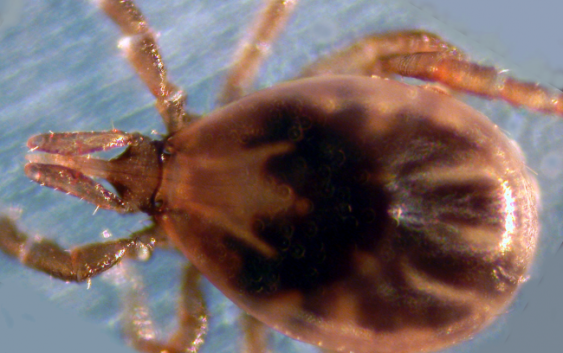Lyme Disease Epidemic: What you need to know

We’ve known about Lyme for many decades now. So why is it growing?
Two factors in particular seem to be making it easier for the tick that carries Lyme, the American blacklegged tick (Ixodes scapularis)—and in Europe, its cousin, the castor bean tick (I. ricinus)—to spread the disease. One is an explosion in the populations of the creatures on whose blood it likes to feed. The other is global warming. Both, of course, are humanity’s fault.
Ticks feed entirely on blood. They need a bloodmeal to graduate from larva to nymph and from nymph to adult—the three stages of their life cycle. Females must take a third bloodmeal to lay eggs. All this usually happens in about the space of two years.
When they hatch (usually) in late spring, tick larvae are tiny—no bigger than the period at the end of this sentence. These newborn ticks are programmed to toddle out to the end of a blade of grass and wait there, squatting with their upper legs outstretched—something scientists call “questing.”
When a suitable animal—usually a small rodent or bird—ambles close enough by, the tiny larva grabs hold. After burrowing through some fur—or hair—the tick latches into a nice patch of skin, saws through flesh, inserts its straw-like mouth-tube, and starts sucking away on blood. Once it has gulped down this first bloodmeal, which takes a few days, the tick drops to the ground, ready to molt into the next stage of its life cycle: a nymph.
For Lyme transmission, this first bloodmeal is critical. A larval tick isn’t born carrying the Lyme spirochetes. It needs to pick up the bacteria from the host it feeds on. Only then, after reawakening as a hungry new nymph, can the tick pass Lyme on to the next host it feeds on.
So what are those typical hosts? In the popular imagination, deer are practically the mascot of Lyme’s seemingly freak emergence—in fact, most people call I. scapularis the “deer tick.” And indeed, the deer population has exploded in the last few decades, after nearing extinction in the 19th century. There have been culls in several states—some of them explicitly to combat Lyme.
Watch this video to get the essential information about Lyme Disease
The milder temperatures caused by global warming are likely a factor paving the way for the blacklegged tick’s ongoing northern invasion. But our rapidly changing climate also seems to be making it easier for Lyme to spread, by shifting when blacklegged ticks typically feed.
The Lyme transmission cycle goes like this. A nymph or adult tick that has already picked up Lyme disease bites an animal. It takes a few weeks for the bacteria to reproduce in the animal’s bloodstream enough for it to become infectious. Any larval ticks that then bite that critter will pick up the disease, passing it on after they in turn molt into nymphs.
Whether the Lyme bacteria keep spreading therefore depends a lot on when each generation of larval ticks is feeding. If larvae happen to feed at the same time as newly emerged nymphs—what biologists call “synchronous feeding”—they’re less likely to pick up the infection, since the bacteria won’t have had enough time to reproduce inside the mammal hosts.
But if newly hatched larval ticks feed much later than the nymphs (“asynchronous feeding”) they’ll be more likely to pick it up—and to transmit it the next season as nymphs.
The best protection against Lyme is not to get bitten. The next best defense is nipping the problem in the blood-filled bud. Since it can take a while for the spirochetes to travel from the tick into the new host’s bloodstream, removing a tick within 24 hours of its attaching dramatically slashes one’s chance of getting Lyme, according to the CDC. And as Avril Lavigne’s experience reveals, getting swift treatment is critical too.
The trouble is, while you might think you’re good at plucking off ticks after a stroll through some underbrush, the ones you find are probably adult ticks. About the size of a match head—and as big as a pea once engorged with blood—they’re relatively easy for vigilant humans to see and feel.
Nymphs, though, are roughly half the size of adults, about the size of a poppy seed. Tiny enough to pass for a smallish mole or freckle, they’re far harder to find than adults are; no surprise, then, that most human Lyme infections come from nymphs. All you can do is to take precautions against getting bitten, search for ticks thoroughly, remove them carefully if you find them, and look out for Lyme symptoms afterwards.
Avril Lavigne is the latest celebrity to reveal being felled by Lyme disease. After months of withering fatigue, the Canadian singer-songwriter was finally diagnosed with the tick-borne illness and now expects a full recovery. Those who take longer to be diagnosed are often less fortunate. Best-selling author Amy Tan’s battle with Lyme left her with 16 brain lesions, epilepsy and, if she misses her course of antibiotics, the inability to recall what she just read. Punk icon Kathleen Hanna’s struggle with the disease all but ended her career.
They’re not the only ones. Around 10% of Americans say they know someone with long-term symptoms of Lyme. Each year, 300,000 US residents contract Lyme, estimates the US Centers for Disease Control (CDC). And given how inconsistently the condition is diagnosed and reported, it could be far more—as many as 3 million cases a year, says Keith Clay, professor of biology at Indiana University. The official number of new US cases—the only available proxy for overall cases—has been growing at double-digit rates.
A similar story is unfolding across the Atlantic. Though the World Health Organization records about 35,000 Lyme cases in Europe each year, other estimates put it at 65,000. Another 3,500 or so occur in Asia.
The US has an epidemic brewing within our borders, and the problem is much more serious than most people realize.
Lyme disease is spreading fast, and it only takes the bite of a poppy-seed-size tick to contract. Even after treatment, symptoms can be difficult to shake.
Those infected can develop severe, rheumatoid arthritis-like joint and muscle pain. Fatigue and neurological disorders — such as numbness, tingling, weakness, and cognitive impairment — can set in too.
Left untreated, infections can lead to brain inflammation or heart problems. At least a handful of such cases have proven fatal.
So many cases go unreported and there’s such a drastic range in the numbers because it’s so easy to miss the signs of infection. Early symptoms are also often dismissed as something more benign.
Meanwhile, Lyme disease infection rates in the US continue to rise. Cases in the US have more than tripled since 1995, according to CDC data.
Early symptoms resemble those of a cold or flu: aches, chills, fever, and swollen glands. Even if you’re attuned to the signs, who wouldn’t shrug them off as something benign?
About three in four people are “lucky” enough to develop a rash that’s sometimes bull’s-eye-shaped, called erythema chronicum migrans — a “smoking gun” sign of Lyme disease — days to a week afterward an infectious bite.
But it can take nearly a month to appear, and it might go unnoticed if it’s small. There’s also some evidence that as few as 60% of infected people get the rash.
The best, first-line treatment is two to four weeks’ worth of antibiotics, usually doxycycline or amoxicillin, within a few days of infection — before B. burgdorferi can get too cozy in joints, nerves, and other tissues.
The tests screen for specific antibodies, which your body creates to fight the bacteria. Thing is, it can take weeks for these to build up to detectable levels. It may take up to three tests or more to confirm Lyme disease.
The high number of Lyme patients seeking additional treatment long after an initial course of antibiotics suggests that so-called best practices for Lyme are inadequate.
What can you do? Avoid to get bitten (it’s easier to say than to do!) and maintain a high immunity level. Give your body the best chance to fight against this and other diseases. In other words: Adopt good nutrition habits and healthy active Lifestyle.
__________________________
Independent Herbalife Member - Healthy FooD Nutrition Blog
Buy Authentic Herbalife Products Online :
*Fast Shipping directly from Herbalife Plant
*Freshest Herbalife Products Guaranteed
*Full Service
>>Click here and Get The Best Quality and Service Available 
Feel free to contact me! Fill the form below


